
Automation in data science has changed the landscape, empowering teams to build complex models faster and with fewer resources.
Automated Machine Learning (AutoML) is at the core of this shift, enabling businesses to leverage predictive models without needing a team of data scientists. In this article, we’ll explore how AutoML works beyond its basics and how it’s reshaping data science.
Understanding AutoML’s Core Processes
Data Preparation and Feature Engineering
Data preparation is the backbone of successful model building, yet it’s tedious and time-consuming. AutoML systems are equipped to automatically handle data preprocessing tasks, such as:
- Data Cleaning: Addressing missing values, handling outliers, and smoothing noisy data.
- Feature Selection: Filtering relevant features from vast datasets.
- Feature Engineering: AutoML can generate new features, transforming data in ways that enhance model performance.
Advanced AutoML platforms, like DataRobot and Google Cloud AutoML, have in-built pipelines that tackle these tasks, freeing data scientists from repetitive work and minimizing errors.

Data Cleaning: Remove or impute missing values.
Feature Selection: Identify and retain only relevant features.
Feature Engineering: Create new features or transform existing ones.
Scaling & Normalization: Standardize feature values for model compatibility.
Data Splitting: Divide data into training, validation, and test sets.
Model Selection: Data is now ready for automated model selection.
Model Selection and Tuning
In traditional machine learning, selecting the best model and tuning its hyperparameters requires in-depth knowledge and trial-and-error. AutoML streamlines this process by:
- Selecting Algorithms: Based on data characteristics, AutoML can select algorithms suited to the problem, such as random forests, neural networks, or gradient-boosting machines.
- Hyperparameter Optimization: AutoML systems experiment with multiple hyperparameters in a fraction of the time, using techniques like grid search and Bayesian optimization to find the optimal settings.
By automating model selection and tuning, AutoML allows data scientists to focus on refining outcomes rather than spending hours manually testing parameters.

Data Characteristics:Numerical Data: Leads to Decision Trees, Neural Networks, or Support Vector Machines, each followed by hyperparameter tuning.
Categorical Data: Directs to CatBoost or Naive Bayes with tuning options.
Mixed Data Types: Suggests Random Forest or Gradient Boosting, each fine-tuned for optimal performance.
This structure illustrates how AutoML tailors model selection and applies hyperparameter tuning to fit different data types.
Automated Model Training and Evaluation
Once models are selected and tuned, they need to be trained and evaluated for performance. AutoML simplifies this by:
- Automated Cross-Validation: Running multiple test-train splits ensures models are well-generalized.
- Performance Metrics Analysis: AutoML provides insights with metrics like accuracy, precision, recall, and F1 scores, presenting the best-fit model for deployment.
With these capabilities, AutoML not only speeds up the process but improves accuracy, giving data scientists more confidence in the reliability of their models.
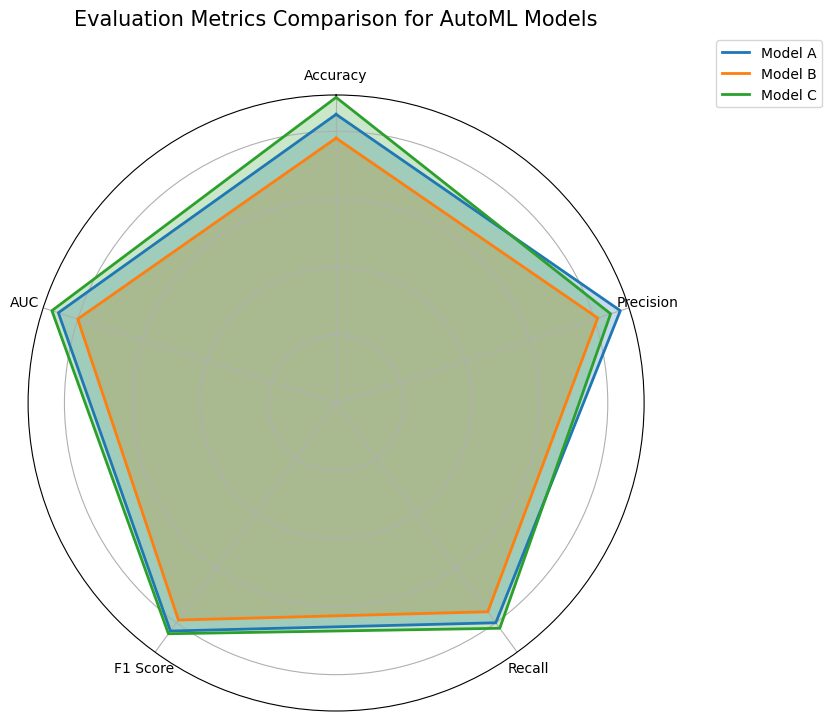
Precision
Recall
F1 Score
AUC (Area Under Curve)
Each model (A, B, and C) has performance scores plotted and connected to illustrate its overall evaluation profile, providing a clear view of each model’s strengths across different metrics.
How AutoML Empowers Non-Technical Teams
Democratizing Data Science
AutoML platforms bridge the gap for non-technical users, enabling them to create and deploy predictive models without advanced knowledge. They typically provide:
- User-Friendly Interfaces: Drag-and-drop dashboards allow users to set up workflows intuitively.
- Guided Workflows: Step-by-step instructions make it easy for anyone to perform tasks, from data upload to model deployment.
- Pre-built Templates: For common use cases, such as customer segmentation or fraud detection, AutoML offers templates that help businesses apply data science to real-world problems without starting from scratch.
This democratization means that business analysts, marketing teams, and even executives can leverage data insights in decision-making processes, enhancing productivity and innovation.
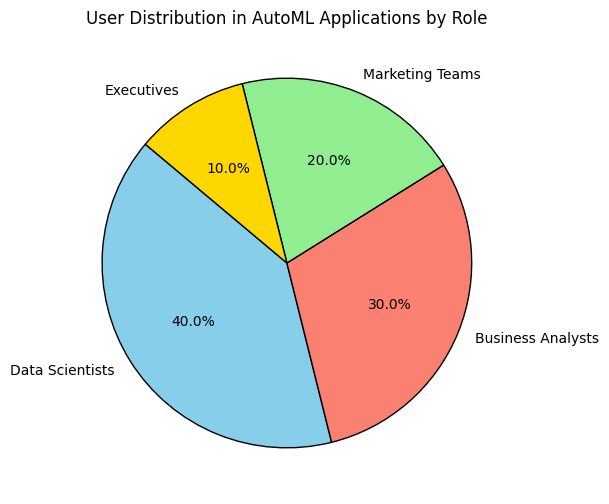
Business Analysts: 30%
Marketing Teams: 20%
Executives: 10%
Each segment is color-coded to highlight the diverse user base of AutoML, emphasizing its accessibility across various professional roles.
Accelerating Time-to-Insights
For companies, faster insights mean a competitive edge. AutoML accelerates the entire machine learning workflow, helping organizations:
- Reduce Project Timelines: Processes that traditionally took weeks can now be completed in hours or days.
- Quickly Scale Models: Once a workflow is defined, it can be easily replicated, allowing teams to apply similar analyses across different datasets or regions.
- Immediate Feedback Loops: Models can be retrained with fresh data, making it easier to adjust strategies as market conditions change.
By shortening the path to insights, AutoML helps businesses remain agile and responsive, even in fast-changing industries like finance, retail, and healthcare.
Enabling Consistent Model Monitoring and Maintenance
Maintaining model accuracy and relevance over time is a critical yet often overlooked aspect of machine learning. AutoML platforms facilitate this by:
- Providing Continuous Monitoring: They alert users when model performance dips, so teams can investigate and address potential issues.
- Automating Retraining: For models impacted by data drift, AutoML can retrain them automatically, ensuring predictions stay reliable as data evolves.
- Documenting Results: AutoML systems often offer robust documentation, providing an audit trail of model iterations and performance metrics.
This ensures that models remain useful and accurate, reducing risks associated with outdated or biased predictions.
Advanced Techniques in AutoML: Beyond Basic Automation

Transfer Learning and Model Ensembling
As AutoML matures, it’s adopting techniques once exclusive to expert data scientists. Transfer learning and model ensembling are two areas where advanced AutoML platforms are making strides:
- Transfer Learning: Leveraging pre-trained models for new tasks is becoming standard in image and NLP projects, allowing AutoML to apply pre-learned features to similar datasets.
- Model Ensembling: Combining predictions from multiple models (e.g., decision trees, neural networks) improves overall performance. AutoML can automatically build and evaluate these ensembles, creating more robust, reliable models.
These techniques allow AutoML to go beyond single-model approaches, resulting in higher accuracy and better generalization.
Explainability in Automated Models
One common concern with AutoML is transparency—understanding how a model arrives at its predictions. Advanced platforms are now incorporating explainability features:
- Interpretable Outputs: Showing which features are most influential in predictions helps stakeholders understand model behavior.
- Global and Local Interpretability: AutoML systems now support explainability at both the dataset (global) and individual prediction (local) levels, offering insights into each prediction’s rationale.
By making AutoML models more transparent, companies can trust their insights more fully and comply with regulatory standards like GDPR, which mandate model explainability.
Customization and Control in Automated Pipelines
While AutoML systems aim to minimize manual intervention, they’re evolving to include customization for users with technical skills. New features include:
- Pipeline Customization: Allowing data scientists to alter specific steps, such as feature engineering or model selection, if they prefer to apply unique domain insights.
- Algorithm Customization: Users can now integrate their algorithms or adjust parameters beyond the AutoML defaults, ensuring the model aligns with their specific requirements.
- Integration with CI/CD Pipelines: Advanced platforms offer compatibility with Continuous Integration and Continuous Deployment (CI/CD) systems, enabling teams to incorporate AutoML models into production seamlessly.
This flexibility empowers data scientists who want to harness AutoML’s speed while retaining creative control over the modeling process.
Real-World Applications and Use Cases
Healthcare: Predictive Analytics for Patient Care
In healthcare, predictive analytics can be a matter of life and death. AutoML is being used to predict patient outcomes, optimize treatment plans, and forecast hospital readmission rates. Leading institutions use AutoML for:
- Early Disease Detection: Analyzing patient records to predict diseases like diabetes or cancer at earlier stages.
- Optimizing Treatment Paths: Finding the most effective treatments based on historical patient data.
- Resource Management: Forecasting patient flow to improve staffing and inventory.
The ability to deploy predictive models without a full data science team has allowed more hospitals to integrate data-driven insights into patient care, improving both outcomes and efficiency.
Retail and E-commerce: Personalization and Demand Forecasting

Enhancing Customer Personalization
AutoML is revolutionizing the retail and e-commerce industries by helping brands offer more personalized experiences. With minimal manual work, AutoML can analyze browsing behaviors, purchase histories, and demographic data to:
- Predict Product Preferences: By assessing customer trends, AutoML systems suggest items tailored to individual tastes, improving user experience and conversion rates.
- Optimize Product Recommendations: Dynamic recommendation engines powered by AutoML adapt in real-time as customer preferences shift.
- Segment Customer Bases: AutoML clusters customers based on behavior patterns, allowing brands to create targeted marketing strategies for different segments.
Personalization at this level can significantly boost customer loyalty and retention rates, giving brands a competitive advantage in crowded markets.
Demand Forecasting for Inventory Optimization
Inventory mismanagement is costly, leading to either surplus or stockouts. With AutoML’s advanced demand forecasting, retailers can optimize inventory by:
- Predicting Seasonal Trends: AutoML models analyze historical sales data to predict demand fluctuations, especially around peak seasons or sales events.
- Managing Supplier Lead Times: Forecasting demand enables timely supplier orders, ensuring stock is available when needed.
- Minimizing Waste: For retailers selling perishable goods, accurate forecasting reduces spoilage by aligning stock levels with demand.
By reducing overstock and ensuring product availability, AutoML helps retailers maximize profitability and improve supply chain efficiency.
Financial Services: Fraud Detection and Risk Assessment
Advanced Fraud Detection
Financial institutions rely heavily on automated solutions to detect and prevent fraud. AutoML is integral in identifying suspicious activities faster and more accurately by:
- Analyzing Transaction Patterns: AutoML flags unusual patterns by comparing them with historical data, identifying potential fraud before it impacts the business.
- Real-Time Alerts: Once suspicious activities are detected, AutoML systems generate alerts in real time, allowing for immediate response.
- Reducing False Positives: Machine learning models, optimized via AutoML, distinguish genuine activities from potential fraud, minimizing interruptions to legitimate transactions.
AutoML-powered fraud detection saves financial institutions billions annually and builds customer trust by protecting their data and transactions.
Risk Assessment and Credit Scoring
Traditional credit scoring methods can overlook nuanced patterns. AutoML enhances risk assessment processes, giving institutions more reliable insights for lending decisions. It helps by:
- Evaluating Alternative Data: AutoML systems analyze diverse data sources—social behavior, financial habits, and demographic info—for a well-rounded credit profile.
- Scoring Small Businesses: Small businesses often lack substantial credit history, but AutoML can build models based on limited data, broadening access to capital for startups and entrepreneurs.
- Dynamic Risk Models: Financial institutions can retrain models with recent data, ensuring credit scores remain current with market trends.
By automating these processes, AutoML improves credit decision accuracy and ensures financial stability for both lenders and borrowers.
Manufacturing: Predictive Maintenance and Quality Control
Predictive Maintenance to Reduce Downtime
For manufacturing, equipment failure is costly. Predictive maintenance, powered by AutoML, reduces unplanned downtime and optimizes machinery lifespan by:
- Analyzing Sensor Data: AutoML assesses data from machine sensors to predict when equipment might fail, scheduling maintenance at the right time.
- Preventing Costly Repairs: Early failure detection allows for minor fixes before costly breakdowns occur.
- Reducing Production Interruptions: Predictive maintenance ensures a steady production flow, preventing unexpected stops that lead to delays.
Manufacturers using predictive maintenance see reductions in operational costs and greater equipment efficiency.
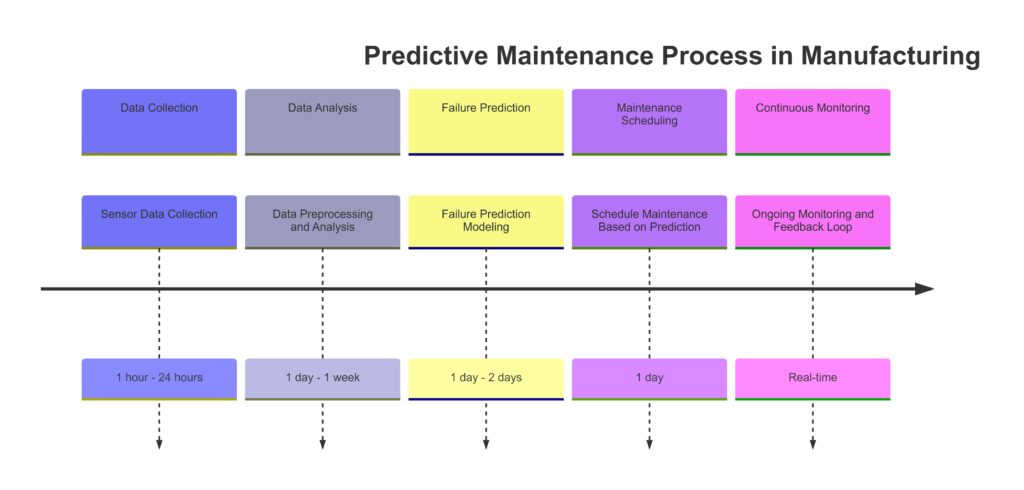
Sensor Data Collection: 1 hour – 24 hours, gathering data from sensors.
Data Analysis: 1 day – 1 week, preprocessing and analyzing data.
Failure Prediction: 1 day – 2 days, modeling for predicting potential failures.
Maintenance Scheduling: 1 day, setting up maintenance based on predictions.
Continuous Monitoring: Real-time, ongoing data collection and feedback loop.
Quality Control Automation
Maintaining consistent product quality is crucial in manufacturing. AutoML plays a pivotal role by automating quality control through:
- Image Recognition for Defect Detection: In industries like electronics and automotive, AutoML models trained on visual data detect defects that might escape human inspection.
- Process Optimization: By analyzing data from various production stages, AutoML identifies optimal parameters to maximize quality.
- Reducing Scrap and Rework Costs: Early detection of faults ensures products meet standards before they reach customers, reducing returns and improving brand reputation.
Automated quality control helps manufacturers deliver reliable products, increasing customer satisfaction and profit margins.
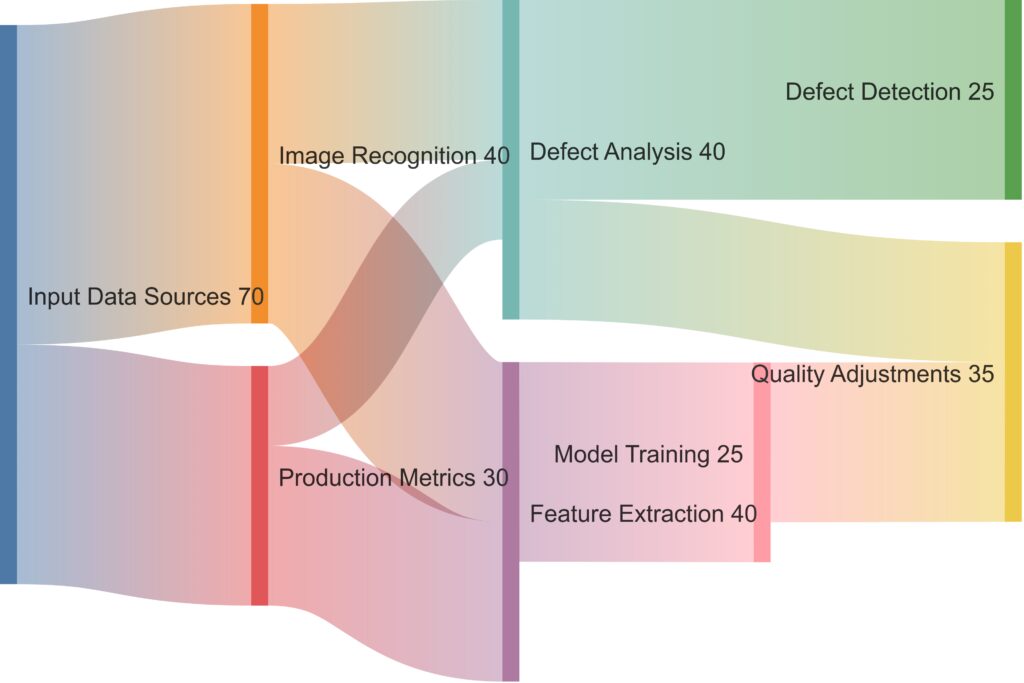
Input Data Sources:Image Recognition and Production Metrics feed into analysis stages with varying data volumes.
Analysis Stages:Defect Analysis receives data from both sources to support defect detection and quality adjustments.
Feature Extraction processes key data elements to assist in model training.
Outcomes:Defect Detection and Quality Adjustments represent the final actions taken to maintain quality.
The Future of AutoML: What’s Next?
Customizable AutoML Solutions
The future of AutoML will likely include even more customizable solutions, where users have granular control over each step of the pipeline. This will:
- Empower Domain Experts: Specialists will be able to refine AutoML processes specific to their industries, enhancing model relevancy.
- Blend Human and Automated Expertise: Advanced AutoML platforms will integrate human insights with automated workflows, enabling a synergy between domain expertise and machine learning efficiency.
This customization will make AutoML even more adaptable, broadening its application across diverse industries.
Ethical Considerations and Regulatory Compliance
As more organizations adopt AutoML, ethical concerns around bias, transparency, and regulatory compliance will increase. Future platforms will focus on:
- Bias Detection and Mitigation: AutoML systems will include tools to detect and correct algorithmic biases, promoting fairer outcomes.
- Enhanced Explainability: Regulatory standards, like the GDPR, mandate transparency in model decision-making. AutoML platforms will continue to develop features that provide clear explanations for each prediction.
- Data Privacy Protections: With data privacy concerns growing, AutoML platforms will adopt stricter security protocols to ensure data integrity and compliance.
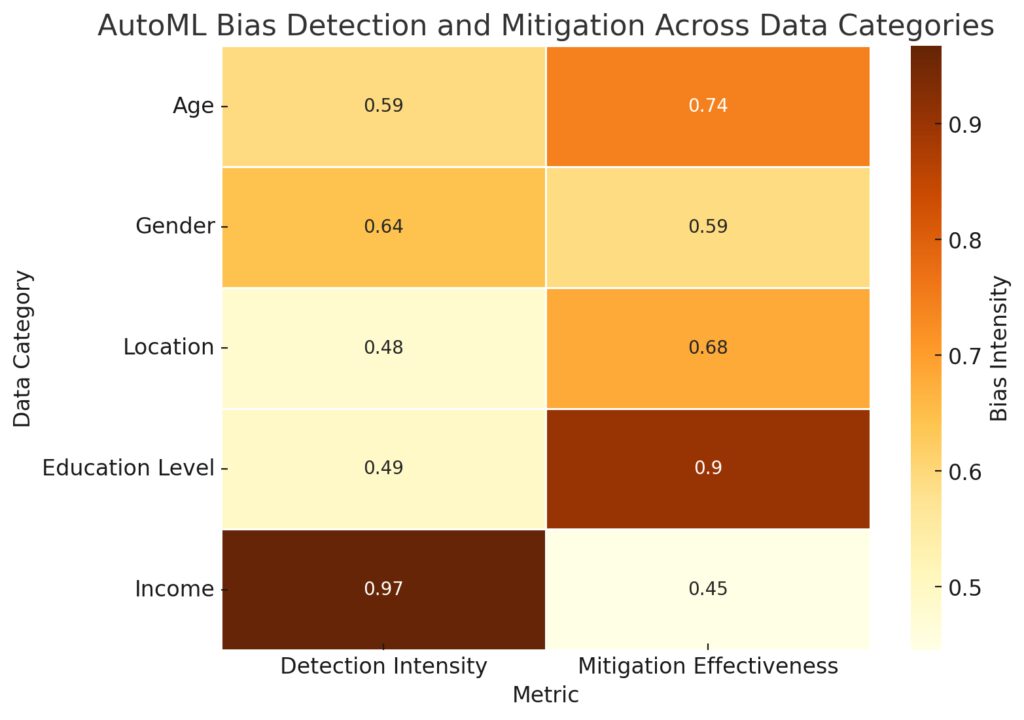
Metrics:Detection Intensity: Measures the degree to which bias is identified in each category.
Mitigation Effectiveness: Indicates the success of bias-reducing techniques applied.
The color gradient, from light to dark, represents bias intensity, with darker shades indicating higher bias levels. This visualization helps highlight areas where AutoML is more or less effective in managing bias.
Ethical, transparent, and privacy-focused AutoML solutions will empower companies to innovate responsibly, building trust among stakeholders and customers.
Automated Machine Learning continues to advance, offering both technical and business-oriented users powerful tools for predictive modeling. AutoML is no longer just a convenience; it’s becoming a crucial element in transforming industries, creating opportunities, and optimizing operations worldwide.
As it evolves, AutoML will further embed itself as a cornerstone of modern data science, driving a future where insights are not just accessible, but actionable for everyone.
FAQs
Can AutoML replace data scientists?
While AutoML reduces the need for some traditional data science tasks, it isn’t a complete replacement for data scientists. Instead, it empowers data scientists by automating repetitive processes, enabling them to focus on more complex, strategic tasks. For instance, data scientists still play a critical role in interpreting results, refining models, and integrating domain knowledge. AutoML complements data scientists’ expertise, making their workflows more efficient but not replacing the human insight needed for nuanced problems.
How does AutoML ensure model transparency and explainability?
Advanced AutoML platforms include explainability tools that offer insights into how models make predictions. They provide features like global interpretability (showing overall feature importance) and local interpretability (explaining individual predictions). These tools allow users to understand model behavior, comply with regulatory standards, and address ethical concerns. Additionally, some platforms provide visualizations and explanations that make model decisions more transparent for stakeholders and end-users.
Is AutoML only useful for large companies with big data?
No, AutoML is useful for businesses of all sizes, not just those handling big data. Smaller companies can leverage AutoML to make sense of their data without hiring a full data science team. Many AutoML tools are scalable and work well with smaller datasets, offering valuable insights and optimizing processes across industries, regardless of company size. This accessibility allows smaller businesses to remain competitive in data-driven markets.
How does AutoML handle data preprocessing?
AutoML platforms automate the data preprocessing stage, handling tasks like data cleaning, feature engineering, data normalization, and categorical encoding. These platforms detect issues such as missing values, outliers, or irrelevant features and apply necessary transformations automatically. Some advanced platforms even generate new features to enhance model accuracy, ensuring that data is well-prepared without requiring extensive manual intervention. This automation streamlines data handling, saving time and improving model outcomes.
Can AutoML detect and prevent bias in models?
Yes, many modern AutoML tools have built-in capabilities to identify and mitigate bias. These platforms can assess potential biases in data and model outputs, flagging areas where bias might influence predictions. Some AutoML tools include fairness metrics and allow users to adjust features or parameters to reduce biased outcomes. However, the involvement of data scientists is often required to interpret and address complex bias issues, as human oversight remains essential in ensuring ethical model practices.
What are some common applications of AutoML?
AutoML is widely applicable across various industries. In finance, it’s used for fraud detection and credit scoring. In healthcare, it aids in predicting patient outcomes and optimizing treatment plans. Retail uses AutoML for demand forecasting and personalized recommendations, while manufacturing leverages it for predictive maintenance and quality control. Essentially, any industry relying on data analysis for decision-making can benefit from AutoML’s automation and speed.
How secure is AutoML when dealing with sensitive data?
AutoML platforms prioritize data security, often including encryption protocols, access controls, and data anonymization techniques to protect sensitive information. Many enterprise-grade AutoML solutions comply with data privacy regulations like GDPR and HIPAA, ensuring that data processing is safe and compliant. However, users should verify the security standards of individual platforms, especially when handling highly sensitive data.
Can AutoML be customized for specific business needs?
Yes, many AutoML platforms offer customization options that allow businesses to tailor models to their unique needs. Users can often adjust parameters, select specific algorithms, and modify preprocessing steps. Some advanced AutoML tools allow pipeline customization and algorithm integration, where users can bring in custom code or models. This flexibility ensures that businesses with specific requirements—such as compliance needs or unique data structures—can still leverage AutoML effectively while retaining control over critical aspects of the modeling process.
What is the role of hyperparameter tuning in AutoML?
Hyperparameter tuning is a crucial step in optimizing a model’s performance, and AutoML platforms handle it automatically. They use techniques like grid search, random search, and Bayesian optimization to identify the best combination of hyperparameters for a given model. This automation reduces the trial-and-error typically required, enhancing model accuracy and performance without demanding intensive manual effort from data scientists. Efficient hyperparameter tuning is one of the main reasons AutoML models can achieve high-quality results quickly.
How does AutoML manage continuous learning and model updates?
AutoML systems can automate the retraining process, enabling models to learn from new data over time, a concept known as continuous learning. When data patterns shift (data drift), these platforms can detect the changes and retrain models, ensuring predictions remain accurate and relevant. Additionally, many AutoML tools include features for model monitoring that alert users when model performance declines, allowing businesses to maintain high-performing models with minimal manual intervention.
What are the limitations of AutoML?
While AutoML is highly beneficial, it has some limitations. Complex problem-solving and highly specialized models may still require the expertise of data scientists. Also, AutoML may lack flexibility when it comes to highly customized modeling approaches. Some platforms may face challenges with interpretability in highly complex models, making it difficult for end-users to understand model decisions. Lastly, data quality remains crucial; AutoML cannot fully compensate for poorly collected or highly biased data. Despite these limitations, AutoML significantly accelerates and simplifies standard machine learning workflows, making it invaluable for many applications.